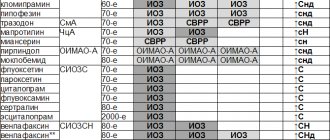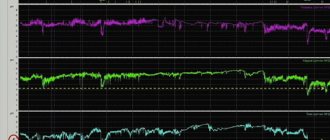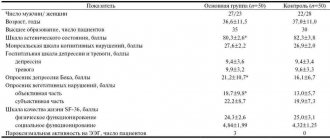Pharmacodynamics and pharmacokinetics
The drug has the properties of nicotinic acid and drugs of the theophylline group: improves collateral circulation , expands the lumen of peripherally located vessels, has a pronounced antiplatelet effect , enhances the process of ATP synthesis and oxidative phosphorylation.
The principle of action is based on substrate stimulation of the synthesis of NAD-phosphate and NAD, on increasing the intracellular content of cAMP, on blocking phosphodiesterase and adenosine receptors.
Xanthinol Nicotinate improves tissue nutrition, oxygenation, and microcirculation . With long-term use, there is an increase in lipoprotein lipase activity, a decrease in the concentration of atherogenic lipids and cholesterol, activation of fibrinolysis processes, an anti-atherosclerotic effect , platelet aggregation decreases, and blood viscosity decreases.
The medication reduces the severity of the effects of cerebral hypoxia, enhances cerebral circulation , helps to increase MBF, enhances myocardial contraction, and reduces peripheral vascular resistance.
The drug is characterized by a “nicotine-like syndrome”, which manifests itself as an exacerbation of the sensitivity of taste and olfactory sensations due to hyperesthesia of the mucous membranes of the oral and nasal cavities.
Pharmacological properties of the drug Xanthinol nicotinate
Pharmacodynamics. Xanthinol nicotinate has the effects of theophylline and nicotinic acid: the mechanism of action is realized through blockade of phosphodiesterase activity, competition with adenosine for receptors, accumulation of cyclic AMP, stimulation of the synthesis of nicotinamide coenzymes and anticycline in the walls of blood vessels. The drug dilates peripheral blood vessels, improves collateral and cerebral blood flow, reduces manifestations of cerebral hypoxia, platelet aggregation, improves microcirculation in the retina, enhances the contractile function of the heart, improves metabolic processes in brain tissue in the postoperative period, reduces the level of cholesterol, atherogenic lipoproteins, uric acid , fibrinogen, increases the activity of lipoprotein lipase, enhances fibrinolysis. Pharmacokinetics. In the body, the drug quickly turns first into theophylline and nicotinic acid, then into their metabolites. Excreted mainly in urine in the form of metabolites. With intramuscular administration, the effect develops within 5–10 minutes.
Indications for use
Xanthinol Nicotinate is prescribed for Raynaud's disease, Buerger's disease (thromboangiitis obliterans), for obliterating atherosclerosis of the vessels of the extremities, for retinopathy, Meniere's syndrome , for migraines, bedsores, trophic ulcers of the leg, for postthrombophlebitic syndrome , for acute thrombophlebitis (with damage to the superficial or deep veins) , with diabetic angiopathy, cerebrovascular insufficiency, with Buschke's scleredema, scleroderma, cerebrovascular accident, with atherosclerosis of cerebral vessels, with hypertriglyceridemia , hypercholesterolemia, atherosclerosis of the coronary arteries, with postpartum and intrauterine asphyxia of the fetus, with dermatoses against the background of impaired trophism of vascular origin.
Contraindications
Xanthinol Nicotinate is not prescribed for glaucoma, severe pathology of the renal system, during pregnancy, arterial hypotension , peptic ulcer of the digestive tract in the acute stage, with mitral stenosis, intolerance to the active substance, with acute bleeding , decompensated form of CHF, with acute heart failure, with acute infarction myocardium.
Publications in the media
(Xantinoli nicotinas) INN
Synonyms. Complamin, Teonicol.
Composition and release form. Tablets and dragees of xanthinol nicotinate 0.15 g; 15% solution of xanthinol nicotinate in ampoules of 2 ml and 10 ml (for drip administration).
Indications. Obliterating arteriosclerosis; intermittent claudication; Raynaud's disease; diabetic angiopathy - retinopathy; trophic ulcers; cerebral circulation disorders, migraine, Meniere's syndrome; ischemic stroke.
Pharmachologic effect. Xanthinol nicotinate combines the properties of theophylline and nicotinic acid. Its vasodilatory effect is associated with inhibition of phosphodiesterase, accumulation of intracellular c-AMP, which leads to inhibition of the connection of myosin with actin and a decrease in the contraction of vascular smooth muscle. Theophylline's ability to block "slow" calcium channels in cell membranes also leads to relaxation of smooth muscles. The nicotine part of the xanthinol nicotinate molecule is a prosthetic group of the enzymes NAD and NADP, which are hydrogen carriers and participate in redox reactions. In addition, it also causes a vasodilator effect.
Pharmacokinetics. See theophylline.
Side effects. Feeling of heat, flushing, tingling and redness of the skin (head and neck); dizziness; hypotension; nausea, diarrhea, gastralgia.
Contraindications. First trimester of pregnancy; acute myocardial infarction, heart failure of II and III degrees; acute hemorrhages; gastric ulcer in the acute stage.
Adverse reactions when interacting with other drugs. When taking xanthinol nicotinate simultaneously with antihypertensive drugs or strophanthin, a sharp decrease in blood pressure is possible.
Information for the patient. The drug is usually started with a dose of 1 tablet 3 times a day; if necessary, the dose is increased to 2-3 tablets 3 times a day. The tablets are swallowed whole without chewing. When taking the drug on an empty stomach, absorption is more complete and rapid. Due to the nicotine part of the drug molecule, its tolerability varies. So, some patients, when taken on an empty stomach, may experience a feeling of warmth, redness of the scalp and neck, general weakness, and hypotension. They are advised to take the drug with or after meals to reduce the above side effects. Take the missed dose as soon as possible, but do not take it at all if there is almost no time left before the next dose: do not take double doses. Elderly patients may be more sensitive to the vasodilatory effect of the drug, so they need to adjust the dose.
Instructions for use of Xanthinol Nicotinate (Method and dosage)
The medicine is used intramuscularly, intravenously (drip, stream) or orally.
Instructions for tablets
It is recommended to swallow the tablets whole. Dosage regimen: three times a day, 150 mg. In some cases, the amount of medication is increased to 300-600 mg (single dose). If the dynamics are positive, the dosage is gradually reduced. The duration of therapy is at least two months.
Xanthinol Nicotinate solution, instructions for use
The drug is administered intramuscularly in the form of a 15% solution of 2-6 ml for 2-3 weeks.
The drug is infused intravenously 1-2 times a day, 2 ml in the form of a 15% solution (the patient must lie on the couch during the procedure). Duration of treatment is 5-10 days. Intravenous drip injections are carried out at a rate of 40-50 drops/minute. Previously, 10 ml of 15% of the drug is diluted in a solution of sodium chloride (0.9% 200 ml) or in a solution of dextrose (5% 200-500 ml).
When diagnosing acute disorders of the blood supply to tissues, in addition to parenteral administration, the drug is simultaneously prescribed in tablet dosage form three times a day, 300 mg.
Xanthinol Nicotinate tablets 150 mg No. 60
Compound
Active substance: xanthinol nicotinate - 150 mg.
Excipients: lactose monohydrate - 15.7 mg, potato starch - 51.3 mg, calcium stearate - 2.3 mg, povidone K17 - 10.7 mg.
Pharmacokinetics
After oral administration of xanthinol, nicotinate is rapidly absorbed from the gastrointestinal tract. In the body it dissociates to form xanthinol and nicotinic acid. Nicotinic acid is less than 20% bound to blood proteins. Preclinical studies on mice showed that nicotinic acid combined with a radioactive isotope accumulates in the liver, kidneys and adipose tissue.
Metabolism of nicotinic acid occurs in the liver. There are two pathways for the metabolism of nicotinic acid: the first pathway is the formation of nicotinamide adenine dinucleotide (NAD) followed by conversion to N-methylnicotinamide and M-methyl-2-pyridone-5 - carboxamide (the main metabolic pathway when taking nicotinic acid in low doses) and the second Pathway: conjugation with glycine to form nicotinic uric acid. Nicotinic acid is excreted in the urine, mainly in the form of metabolites; with repeated administration, up to 12% of the dose of nicotinic acid is excreted in the urine unchanged.
Indications for use
As part of complex therapy: obliterating atherosclerosis of the vessels of the extremities, Raynaud's disease, obliterating endarteritis, diabetic angiopathy, acute thrombophlebitis (superficial and deep veins), trophic ulcers of the legs, cerebrovascular insufficiency, Meniere's syndrome, cerebral atherosclerosis, cerebrovascular accident, atherosclerosis of the coronary arteries , hypercholesterolemia, hypertriglyceridemia.
Contraindications
Hypersensitivity, acute heart failure or decompensated chronic heart failure, acute myocardial infarction, stenosis of the left atrioventricular orifice, arterial hypotension, granzitory arterial hypertension, bleeding, pregnancy (I trimester), acute stage of gastric and duodenal ulcers, acute renal failure, glaucoma.
Lactose intolerance, lactase deficiency or glucose-galactose malabsorption.
Children under 18 years of age.
Directions for use and doses
Prescribed orally for adults, starting with 150 mg 3 times a day; if necessary, the dose is increased to 300-600 mg 3 times a day. The tablets are taken after meals without chewing. As the patient's condition improves, the dose is reduced to 150 mg 2-3 times a day. The course of treatment usually lasts at least 2 months.
In case of acute disorders of the blood supply to tissues, the drug is administered parenterally with simultaneous administration of 300 mg (2 tablets) 3 times a day orally.
Storage conditions
Store in a dry place, protected from light, at a temperature not exceeding 25 °C. Keep out of the reach of children.
Best before date
3 years. Do not use after the expiration date.
special instructions
Use xanthinol nicotinate with caution in labile blood pressure.
Xanthinol nicotinate causes a “nicotine-like” syndrome, accompanied by hyperesthesia of the mucous membrane of the nasal cavity and mouth (exacerbates the sensitivity of the olfactory and taste receptors). In this regard, the smell and taste of alcoholic beverages taken during therapy is perceived as more pungent and perverted.
In patients with diabetes mellitus, glycemia should be carefully monitored.
Avoid contact of xanthinol nicotinate with eyes or mucous membranes.
Description
Vasodilating agent.
Use in children
The use of xanthinol nicotinate in children is contraindicated (no experience of use).
Pharmacodynamics
Combines the properties of substances from the theophylline and nicotinic acid groups: dilates peripheral blood vessels, improves collateral circulation, enhances oxidative phosphorylation and the synthesis of adenosine triphosphate. By reducing peripheral resistance and increasing myocardial contraction, the drug helps to increase minute blood volume. Xanthinol nicotinate increases cerebral circulation and reduces the severity of the effects of cerebral hypoxia.
Side effects
From the cardiovascular system: possible decrease in blood pressure, transient sensation of warmth, redness of the skin.
From the digestive system: rarely - nausea, diarrhea, anorexia, gastralgia; with long-term use in high doses, an increase in the level of transaminases and alkaline phosphatase is possible.
From the nervous system: headache.
Allergic reactions: skin itching, urticaria, angioedema, anaphylactic shock.
Other: weakness, chills, tingling of the skin, especially in the head and neck area (these symptoms usually disappear after 10-20 minutes and do not require special treatment and refusal to use this drug); with long-term use in high doses, changes in glucose tolerance and an increase in the level of uric acid in the blood serum are possible.
When using nicotinic acid preparations, a false increase in the concentration of catecholamines in the blood plasma and urine may be observed, and a false positive result for determining glucose in urine using the Benedict test may also be observed.
Use during pregnancy and breastfeeding
Contraindicated for use in the first trimester of pregnancy. In the second and third trimester of pregnancy, the use of xanthinol nicotinate is permissible only if there are absolute indications, if the expected benefit to the mother outweighs the potential risk to the fetus. Xanthinol nicotinate in this case is used under close medical supervision.
If it is necessary to use xanthinol nicotinate during lactation, breastfeeding must be interrupted, because nicotinic acid is excreted in breast milk.
Interaction
To avoid a sharp decrease in blood pressure, xanthinol nicotinate should not be used simultaneously with antihypertensive drugs (including beta-blockers, alpha-blockers, ganglion blockers). Do not use simultaneously with MAO inhibitors and strophanthin.
The simultaneous use of nicotinic acid preparations in combination with HMG-CoA reductase inhibitors (statins) may increase the risk of developing myopathy and rhabdomyolysis.
Simultaneous use of alcohol may increase the severity of the side effects of xanthinol nicotinate (feeling of heat, redness of the skin).
Overdose
Acute overdose can manifest as arterial hypotension, abdominal pain and vomiting. In case of drug overdose, symptomatic therapy is prescribed.
Impact on the ability to drive vehicles and operate machinery
When using xanthinol nicotinate, dizziness, weakness and arterial hypotension are possible; therefore, during the treatment period, patients should avoid driving vehicles and other activities that require high concentration and speed of psychomotor reactions.
special instructions
It is unacceptable to prescribe the drug Xanthinol Nicotinate in the first trimester of pregnancy. In the second and third trimester, the drug is used subject to careful monitoring of the patient.
Prescribing the drug in large quantities causes dizziness and a drop in blood pressure.
It is necessary to avoid contact of the drug with mucous membranes and eyes.
Not recommended for drivers.
Special instructions for the use of the drug Xanthinol nicotinate
Caution should be exercised when prescribing the drug to patients with gastric and duodenal ulcers in the acute phase, as well as with labile blood pressure. In diabetes mellitus, it is necessary to monitor glycemia more often. For patients with an implanted pacemaker, the drug is used at a lower dose. during pregnancy and breastfeeding is not recommended . Children . The drug is not used in children under 2 years of age, since it contains theophylline component.
Xanthinol Nicotinate price, where to buy
The price of Xanthinol Nicotinate tablets is 200-220 rubles per pack of 60 pieces.
10 ampoules cost about 420 rubles.
- Online pharmacies in RussiaRussia
- Online pharmacies in UkraineUkraine
Pharmacy Dialogue
- Xanthinol nicotinate (amp. 15% 2ml No. 10) Ellara LLC
200 rub. order - Xanthinol nicotinate 15% ampoules 2ml No. 10 Armavirskaya B.F.
88 rub. order
- Xanthinol nicotinate (tab. 150 mg No. 60) Usolye-Sibirsky Chemical Physics Complex
103 rub. order
show more



